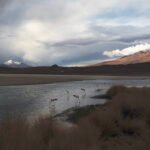Cordillera del Paine with Fujifilm X-E3 and XC 50–230mm
I’m selling a bunch of gear, so I’ll be posting some of my fav images shot with that equipment, sort of as a farewell or a homage.
This one is shot using the budget XC 50-230mm lens. It is a very underrated lens, doubly so because it suffers the ignominity of being the mk I version. (there’s a newer XC 50-230mm II out). So here’s a photo shot with this lowly lens at one of the highest places in South America.
This image began as a challenge: to create a powerful black-and-white landscape that pays tribute to the drama and discipline of Ansel Adams — using my everyday digital kit: a Fujifilm X-E3 and the aforementioned unassuming XC 50–230mm lens.
No large format view camera. No zone metering spot meter the size of a baguette. Just patience, study, and an intent to translate light and form into tone.
The Landscape Demanded Monochrome
Standing before the Cordillera del Paine in Patagonia, I was struck not just by the scale, but by the geometry — angular ridges, hard light, deep shadows — the kind of composition that practically begs to be in black and white.
This wasn’t a photo about vibrant blues or rich greens. It was about shape. Contrast. Weight. Monochrome wasn’t just a stylistic choice — it was the most honest way to render what I saw and felt.
The Gear That Made It Happen
My main camera was a GFX 50S II, but I also brought along my trusty Fujifilm X-E3, It is my travel companion of choice, quick to operate, easy to carry, and delivers files with depth. The XC 50–230mm lens, though often overlooked in favor of pricier glass, is sharp where it counts — especially when stopped down.
I set the shutter speed at 1/1600 because it was extremely windy and especially unforgiving at telephoto distances. I was at about mid-throw of the zoom (so probably 150mm?) and f/5.6, I framed the ridgeline tightly, isolating the drama in the peaks and snowfields. Recalling my university days studying the Zone System, and trusting Fuji’s dynamic range, I exposed for the highlights, knowing I could recover the shadows without compromising detail.
Interpreting the Zone System Digitally
Ansel Adams’ Zone System was about control — not just exposure, but intent. Understanding how every part of your image fits within a tonal framework. I approached this scene with that mindset:
-
Zone II–III: The darkest parts of the midground, rich but with retained texture.
-
Zone V: The gentle gradients on the shadowed rock faces.
-
Zone VIII: The snowlit ridges, pushed just to the edge of pure white — glowing, but not blown out.
It was a conscious act of balancing exposure decisions with emotional tone. For best results, conversion to black and white shouldn’t an afterthought — it has to be decided within the viewfinder at the point of click.
More Than Emulation — A Practice of Discipline
This wasn’t about mimicking Ansel Adams. What’s the point of that? It was about engaging with the principles he shot with: pre-visualization, craftsmanship, and respect for light. It’s easy to be swept away by presets and dramatic contrast sliders, but this image was built slowly — with the goal of capturing the awe-inspiring timelessness of Patagonia.
Photography, at its core, is about interpreting light. Whether you’re using a field camera in Yosemite or a mirrorless Fuji in South America, the tools may differ — but the process remains rooted in patience, vision, and technical understanding.
This photo is my tribute to that legacy. A study in tones. A practice in seeing.
 Previous post
A Portrait Does Not a Soul Capture
Previous post
A Portrait Does Not a Soul Capture
 Next post
Bolivian Flamingoes
Next post
Bolivian Flamingoes

